小学英语语法内容总结及练习
- 格式:doc
- 大小:43.50 KB
- 文档页数:5
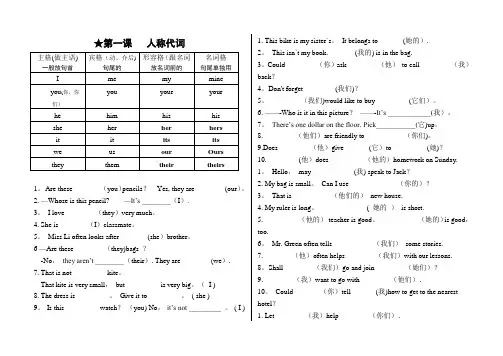
★第一课人称代词1。
Are these ________(you)pencils?Yes, they are ________(our)。
2. —Whose is this pencil? —It’s ________(I).3。
I love ________(they)very much。
4. She is________(I)classmate。
5。
Miss Li often looks after________(she)brother。
6 —Are these ________(they)bags ?-No,they aren’t ________(their). They are ________(we).7. That is not _________ kite。
That kite is very small,but _________ is very big。
(I )8. The dress is _________。
Give it to _________。
( she )9。
Is this _________ watch?(you) No,it’s not _________ 。
( I ) 1. This bike is my sister`s。
It belongs to ______ (她的).2。
This isn`t my book. _______(我的) is in the bag.3。
Could_________(你)ask_________(他)to call_________(我)back?4。
Don't forget_________(我们)?5。
_________(我们)would like to buy_________ (它们)。
6. ——-Who is it in this picture?——-It’s ____________(我)。
7。
There’s one dollar on the floor. Pick___________(它)up。
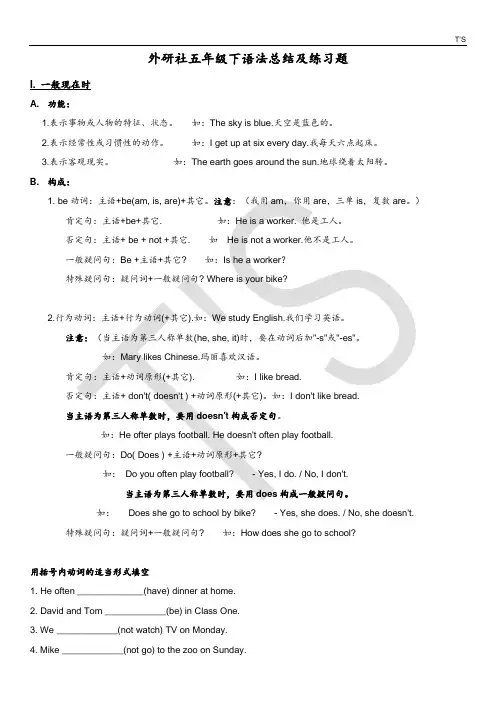
外研社五年级下语法总结及练习题I. 一般现在时A. 功能:1.表示事物或人物的特征、状态。
如:The sky is blue.天空是蓝色的。
2.表示经常性或习惯性的动作。
如:I get up at six every day.我每天六点起床。
3.表示客观现实。
如:The earth goes around the sun.地球绕着太阳转。
B. 构成:1. be动词:主语+be(am, is, are)+其它。
注意:(我用am,你用are,三单is,复数are。
)肯定句:主语+be+其它. 如:He is a worker. 他是工人。
否定句:主语+ be + not +其它. 如He is not a worker.他不是工人。
一般疑问句:Be +主语+其它? 如:Is he a worker?特殊疑问句:疑问词+一般疑问句? Where is your bike?2.行为动词:主语+行为动词(+其它).如:We study English.我们学习英语。
注意:(当主语为第三人称单数(he, she, it)时,要在动词后加"-s"或"-es"。
如:Mary likes Chinese.玛丽喜欢汉语。
肯定句:主语+动词原形(+其它). 如:I like bread.否定句:主语+ don't( doesn't ) +动词原形(+其它)。
如:I don't like bread.当主语为第三人称单数时,要用doesn't构成否定句。
如:He ofter plays football. He doesn't often play football.一般疑问句:Do( Does ) +主语+动词原形+其它?如:Do you often play football?- Yes, I do. / No, I don't.当主语为第三人称单数时,要用does构成一般疑问句。
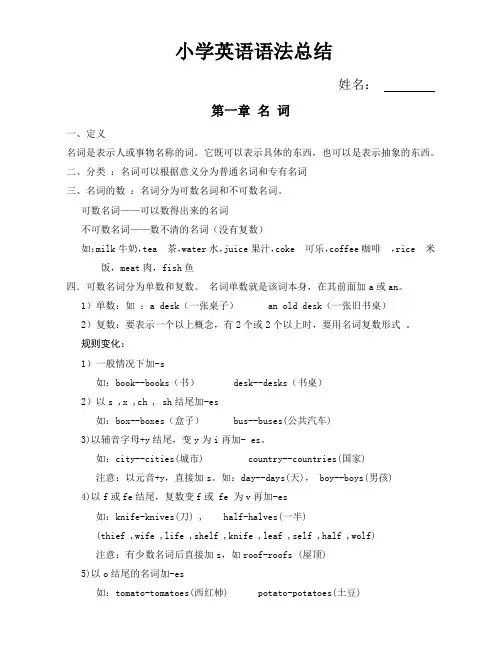
小学英语语法总结姓名:第一章名词一、定义名词是表示人或事物名称的词。
它既可以表示具体的东西,也可以是表示抽象的东西。
二、分类:名词可以根据意义分为普通名词和专有名词三、名词的数:名词分为可数名词和不可数名词。
可数名词——可以数得出来的名词不可数名词——数不清的名词(没有复数)如:milk牛奶,tea 茶,water水,juice果汁,coke 可乐,coffee咖啡,rice 米饭,meat肉,fish鱼四.可数名词分为单数和复数。
名词单数就是该词本身,在其前面加a或an。
1)单数:如:a desk(一张桌子) an old desk(一张旧书桌)2)复数:要表示一个以上概念,有2个或2个以上时,要用名词复数形式。
规则变化:1)一般情况下加-s如:book--books(书) desk--desks(书桌)2)以s ,x ,ch , sh结尾加-es如:box--boxes(盒子) bus--buses(公共汽车)3)以辅音字母+y结尾,变y为i再加- es。
如:city--cities(城市) country--countries(国家)注意:以元音+y,直接加s。
如:day--days(天), boy--boys(男孩)4)以f或fe结尾,复数变f或 fe 为v再加-es如:knife-knives(刀) , half-halves(一半)(thief ,wife ,life ,shelf ,knife ,leaf ,self ,half ,wolf) 注意:有少数名词后直接加s,如roof-roofs (屋顶)5)以o结尾的名词加-es如:tomato-tomatoes(西红杮) potato-potatoes(土豆)注意:zero 两种方式都可:zero-zeros或 zeroes(零)不规则变化1) 元音字母发变化。
如:man--men(男人) , woman--women(妇女) tooth--teeth(牙齿) ,mouse--mice(老鼠) , policeman--policemen(警察) foot--feet(脚) 2) 词尾发生变化。
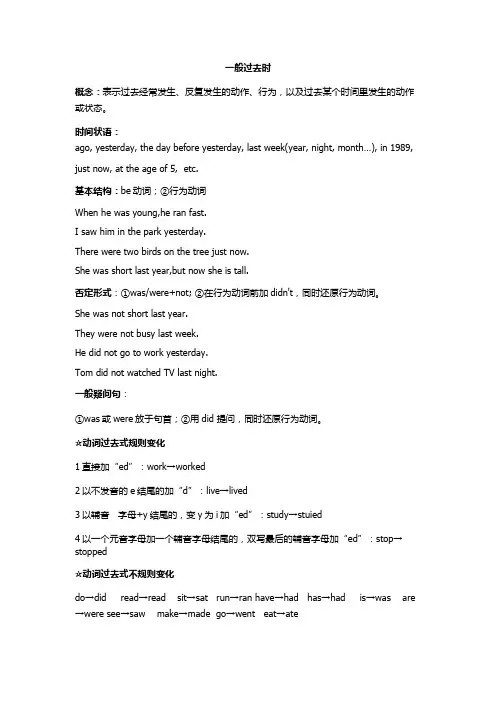
一般过去时概念:表示过去经常发生、反复发生的动作、行为,以及过去某个时间里发生的动作或状态。
时间状语:ago, yesterday, the day before yesterday, last week(year, night, month…), in 1989, just now, at the age of 5, etc.基本结构:be动词;②行为动词When he was young,he ran fast.I saw him in the park yesterday.There were two birds on the tree just now.She was short last year,but now she is tall.否定形式:①was/were+not; ②在行为动词前加didn't,同时还原行为动词。
She was not short last year.They were not busy last week.He did not go to work yesterday.Tom did not watched TV last night.一般疑问句:①was或were放于句首;②用did 提问,同时还原行为动词。
☆动词过去式规则变化1直接加“ed”:work→worked2以不发音的e结尾的加“d”:live→lived3以辅音字母+y结尾的,变y为i加“ed”:study→stuied4以一个元音字母加一个辅音字母结尾的,双写最后的辅音字母加“ed”:stop→stopped☆动词过去式不规则变化do→did read→read sit→sat run→ran have→had has→had is→was are →were see→saw make→made go→went eat→ate一般过去时的练习一、用所给的动词的适当形式填空。
⒈He ___________(visit) the Great Wall last year.2.We____________(have) a good time yesterday.3.We often __________(go) to school by bus last year.4.I __________(live)in the village when I was a child.5.Mike__________(see) a big tiger in the nature park last year.6.Sam___________ (do) the housework yesterday.7.________(do) you _________(enjoy) yourself yesterday?8.________(do)you __________(play) the violin in the artroom yesterday?9.I __________ (eat) a big pizza yesterday.10.There_________ (be) many sheep on the farm last year.11. I _________ (watch) a cartoon on Saturday.12. Her father __________ (read) a newspaper last night.13. We _________ to zoo yesterday, we ___________ to the park. (go)14. _________ you __________ (visit) your relatives last Spring Festival?15. _________ he __________ (fly) a kite on Sunday? Yes, he __________.二、单项选择( ) 1. She watered the flowers ________.A tomorrowB sometimesC yesterday morning( ) 2.What ____ Mike do last weekend ?A doB doesC did( ) 3. I ___ my room last Sunday.A cleanedB cleanC am cleaning( ) 4. _____ you _____ TV last night .A Do, watchB Did, watchC Did, watched( ) 5.---Did your father write an e-mail yesterday ?A Yes, he did.B Yes, he doesC No, he don’t( ) 6.They _____ on a trip in February ,2007.A are goingB goingC went( ) 7. ____ he ____ football two days ago?A Does , playB Did , playedC Did , play三、Be动词的过去时练习(一)用be动词的适当形式填空。
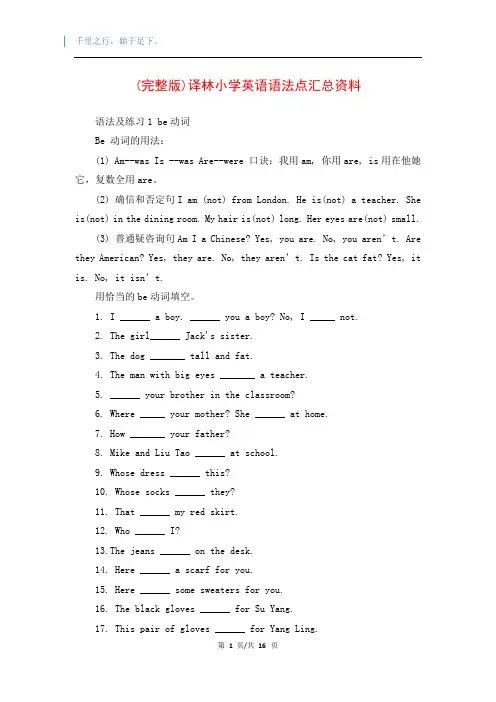
(完整版)译林小学英语语法点汇总资料语法及练习1 be动词Be 动词的用法:(1) Am--was Is --was Are--were 口诀:我用am, 你用are, is用在他她它,复数全用are。
(2) 确信和否定句I am (not) from London. He is(not) a teacher. She is(not) in the dining room. My hair is(not) long. Her eyes are(not) small.(3) 普通疑咨询句Am I a Chinese? Yes, you are. No, you aren’t. Are they American? Yes, they are. No, they aren’t. Is th e cat fat? Yes, it is. No, it isn’t.用恰当的be动词填空。
1. I ______ a boy. ______ you a boy? No, I _____ not.2. The girl______ Jack's sister.3. The dog _______ tall and fat.4. The man with big eyes _______ a teacher.5. ______ your brother in the classroom?6. Where _____ your mother? She ______ at home.7. How _______ your father?8. Mike and Liu Tao ______ at school.9. Whose dress ______ this?10. Whose socks ______ they?11. That ______ my red skirt.12. Who ______ I?13.The jeans ______ on the desk.14. Here ______ a scarf for you.15. Here ______ some sweaters for you.16. The black gloves ______ for Su Yang.17. This pair of gloves ______ for Yang Ling.18. The two cups of milk _____ for me.19. Some tea ______ in the glass.20. Gao shan's shirt _______ over there.21. My sister's name ______Nancy.22. This ______ not Wang Fang's pencil.23. ______ David and Helen from England?24. There ______ a girl in the room.25. There ______ some apples on the tree.26. _______ there any kites in the classroom?27. _______ there any apple juice in the bottle?28. There _______ some bread on the plate.29. There _______ a boy, two girls, three men and ten women in the park.语法及练习2 人称代词和物主代词人称代词和物主代词1.人称代词主格和宾格的区不:主格通常位于句中第一具动词之前(有时候位于than 之后),宾格普通位于动词或介词之后。
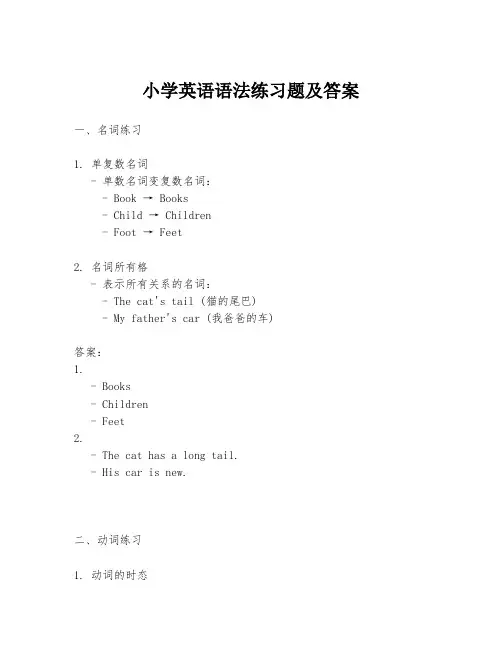
小学英语语法练习题及答案一、名词练习1. 单复数名词- 单数名词变复数名词:- Book → Books- Child → Children- Foot → Feet2. 名词所有格- 表示所有关系的名词:- The cat's tail (猫的尾巴)- My father's car (我爸爸的车)答案:1.- Books- Children- Feet2.- The cat has a long tail.- His car is new.二、动词练习1. 动词的时态- 现在进行时:- She is reading a book.- 一般过去时:- They walked to school.2. 动词的第三人称单数- He plays football every day.答案:1.- She is reading a book now.- Yesterday, they walked to school. 2.- He plays football every day.三、形容词和副词练习1. 形容词比较级和最高级- 比较级:Bigger, faster- 最高级:The biggest, the fastest2. 副词的使用- 副词修饰动词:- She runs quickly.答案:1.- The cat is bigger than the dog.- This is the fastest car in the race.2.- She runs quickly to catch the bus.四、代词练习1. 人称代词- 主格代词:I, you, he, she, it- 宾格代词:me, you, him, her, it2. 物主代词- 形容词性物主代词:my, your, his, her, its - 名词性物主代词:mine, yours, his, hers, its答案:1.- I am going to the park. (主格)- Can you pass the ball to me? (宾格)2.- This is my book. (形容词性)- The book is mine. (名词性)五、介词练习1. 表示时间的介词- In, on, at- In the morning, on Monday, at 5 o'clock2. 表示地点的介词- In, on, at, to- In the classroom, on the desk, at the zoo, to the library答案:1.- I wake up in the morning.- We have a party on my birthday.- The meeting starts at 3 PM.2.- The cat is in the box.- The book is on the table.- We go to the park.六、疑问句练习1. 一般疑问句- Do you like apples?- Does she have a sister?2. 特殊疑问句- What is your name?- Where are you going?答案:1.- Yes, I do.- No, she doesn't.2.- My name is Tom.- I am going to the cinema.。
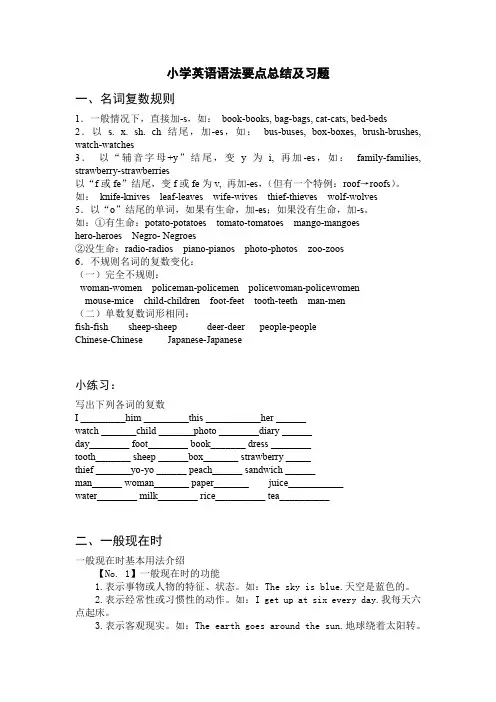
小学英语语法要点总结及习题一、名词复数规则1.一般情况下,直接加-s,如:book-books, bag-bags, cat-cats, bed-beds2.以s. x. sh. ch结尾,加-es,如:bus-buses, box-boxes, brush-brushes, watch-watches3.以“辅音字母+y”结尾,变y为i, 再加-es,如:family-families, strawberry-strawberries以“f或fe”结尾,变f或fe为v, 再加-es,(但有一个特例:roof→roofs)。
如:knife-knives leaf-leaves wife-wives thief-thieves wolf-wolves5.以“o”结尾的单词,如果有生命,加-es;如果没有生命,加-s。
如:①有生命:potato-potatoes tomato-tomatoes mango-mangoeshero-heroes Negro- Negroes②没生命:radio-radios piano-pianos photo-photos zoo-zoos6.不规则名词的复数变化:(一)完全不规则:woman-women policeman-policemen policewoman-policewomenmouse-mice child-children foot-feet tooth-teeth man-men(二)单数复数词形相同:fish-fish sheep-sheep deer-deer people-peopleChinese-Chinese Japanese-Japanese小练习:写出下列各词的复数I _________him _________this ___________her ______watch _______child _______photo ________diary ______day________ foot________ book_______ dress ________tooth_______ sheep ______box_______ strawberry _____thief _______yo-yo ______ peach______ sandwich ______man______ woman_______ paper_______ juice___________water________ milk________ rice__________ tea__________二、一般现在时一般现在时基本用法介绍【No. 1】一般现在时的功能1.表示事物或人物的特征、状态。
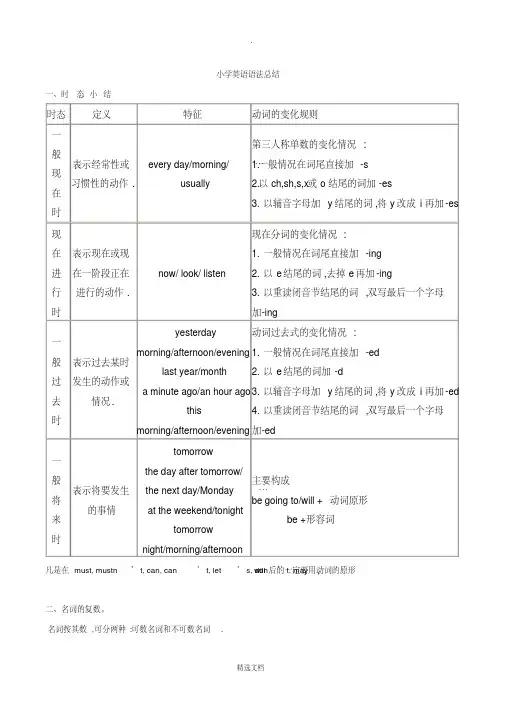
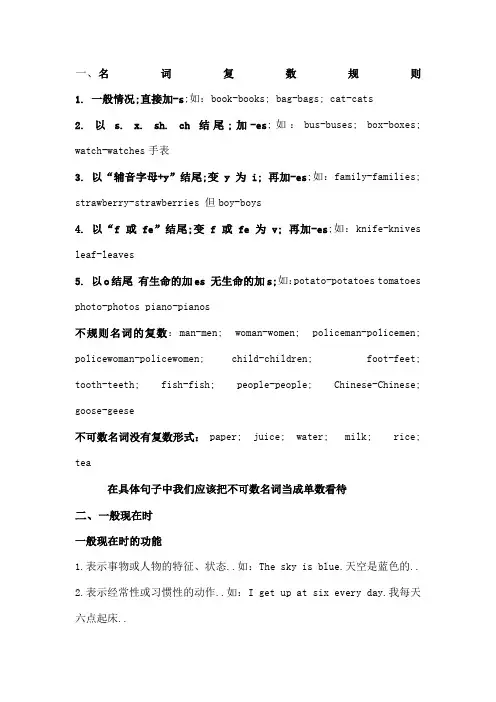
一、名词复数规则1. 一般情况;直接加-s;如:book-books; bag-bags; cat-cats2. 以s. x. sh. ch结尾;加-es;如:bus-buses; box-boxes; watch-watches手表3. 以“辅音字母+y”结尾;变y为i; 再加-es;如:family-families; strawberry-strawberries 但boy-boys4. 以“f或fe”结尾;变f或fe为v; 再加-es;如:knife-knives leaf-leaves5. 以o结尾有生命的加es 无生命的加s;如:potato-potatoes tomatoes photo-photos piano-pianos不规则名词的复数:man-men; woman-women; policeman-policemen; policewoman-policewomen; child-children; foot-feet; tooth-teeth; fish-fish; people-people; Chinese-Chinese; goose-geese不可数名词没有复数形式: paper; juice; water; milk; rice; tea在具体句子中我们应该把不可数名词当成单数看待二、一般现在时一般现在时的功能1.表示事物或人物的特征、状态..如:The sky is blue.天空是蓝色的..2.表示经常性或习惯性的动作..如:I get up at six every day.我每天六点起床..3.表示客观现实..如:The earth goes around the sun.地球绕着太阳转..一般现在时的标志词:often; usually; sometimes; every等一般现在时的构成主语+动词原形..如: We study English. 我们学习英语..当主语为第三人称单数he; she; it;my father等时主语三单+动词的三单形式要在动词后加"-s"或"-es"如:Mary likes Chinese.玛丽喜欢汉语..一般现在时的变化否定句:主语+ don't doesn't +动词原形+其它.. 如: I don't like bread. He doesn't like bread; too.一般疑问句:Do Does +主语+动词原形+其它.. 如: Do you go to school by bike Yes; I do. / No; I don't.当主语为第三人称单数时;要用does构成一般疑问句.. 如: Does she go to school by bike Yes; she does. / No; she doesn't.特殊疑问句:特殊疑问词+一般疑问句..如:How dou you go to school How does your father go to work动词的第三人称单数的变化规则1.一般情况下;直接加-s;如:cook-cooks; make-makes2.以s. x. sh. ch. o结尾;加-es;如: wash-washes; watch-watches; go-goes3.以“辅音字母+y”结尾;变y为i; 再加-es;如:study-studies 但play-plays不规则变化have-has三、现在进行时1.现在进行时表示现在正在进行或发生的动作..2.现在进行时的肯定句基本结构:主语+be+ 动词ing. 如: I am eating.现在进行时的否定句基本结构:主语+be not + 动词ing. 如: I am not eating.现在进行时的一般疑问句基本结构: be动词 +主语 +动词ing. 如: Are you eating现在进行时的特殊疑问句基本结构:特殊疑问词+ be +主语+动词ing如:What are you eating动词的ing形式动词的现在分词的变化规则1 一般情况下直接在动词后面加ingread--reading sleep---sleeping study---studying clean--cleaning play---playing2 以不发音的字母e结尾的动词;去掉字母e;再加ingcome---coming make---making ride---riding have---having take---takingwrite---writing dance---dancing3 以重读闭音节重读闭音节即两个辅音中间夹一个元音并且重读的音节结尾;呈现“辅;元;辅”结构的动词;双写末尾的辅音字母;再加ingstop--stopping停sit--sitting坐run--running跑begin—beginning开始cut--cutting切get--getting得到swim--swimming游dig--digging挖四、一般将来时一、概念:表示将要发生的动作以及打算或者准备做某事..句中一般有以下时间状语:tomorrow; this weekeng; next dayweek; month; year…;等..二、基本结构:①主 + be going to + 动词原形;②主 +will+ 动词原形.I am going to play football tomorrow明天. = I will play football tomorrow.三、否定句:在be动词am; is; are后加not;主 + be not going to + 动词原形..例如:I’m going to have a picnic this afternoon.→ I’m not going to have a picnic this afternoon.四、一般疑问句:把be提到句首;some改为any; 第一二人称互换..Be + 主+ going to +动词原形例如:We are going to swim this weekend. → Are you going to swim this weekend五、一般过去时1.一般过去时表示过去某个时间发生的动作或存在的状态;常和表示过去的时间状语连用..一般过去时也表示过去经常或反复发生的动作.. 2.一般过去时Be动词的变化:3.⑴ am 和is在一般过去时中变为was..was not=wasn’t4.⑵ are在一般过去时中变为were..were not=weren’t5.⑶带有was或were的句子;其否定、疑问的变化和is; am; are一样;即否定句在was或were后加not;一般疑问句把was或were调到句首.. 3.没有be动词的一般过去时肯定句:主语+动词过去式如: Jim went home yesterday. 否定句:主语+didn’t +动词原形如:Jim didn’t go home yesterday.一般疑问句: Did+主语+动词原形如:Did Jim go home yesterday特殊疑问句:⑴疑问词+did+主语+动词原形如: What did Jim do yesterday⑵疑问词当主语时:疑问词+动词过去式如:Who went to home yesterday动词过去式变化规则:1.一般在动词末尾加-ed;如:clean-cleaned; cook-cooked2.以不发音的e结尾的在词尾加d;如:like-liked live-lived3.末尾有一个元音字母和一个辅音字母的重读闭音节;双写末尾的辅音字母;加-ed;如:stop-stopped4.以“辅音字母+y”结尾的;变y为i; 再加-ed;如:study-studied 但play-played5.不规则动词过去式:am; is-was; are-were; do-did; see-saw; get-got; go-went; come-came; have-had; eat-ate; take-took; sing-sang; put-put; make-made; read-read; write-wrote; draw-drew; fly-flew; ; swim-swam六、比较级1、比较级在句子中的运用:两个事物或人的比较用比较级;比较级后面一般带有单词than..一般句式的构成:A + is / are+ 形容词比较级+ than + BA 是主格B 是宾格如: She is taller than me.2.形容词加er的规则:⑴一般在词尾加er 如:small--smaller clean--cleaner ;⑵以字母e 结尾;加r 如:fine--finer nice--nicer;⑶闭音节单音节词如末尾只有一个辅音字母;须先双写这个辅音字母;再加-er 如:big--bigger hot--hotter ;⑷以“辅音字母+y”结尾;先把y变i;再加er 如:heavy--haevier easy--easier..3.不规则形容词比较级:4. good-better;5.七、There be 句型与have; has的区别1、There be 句型表示:在某地有某物或人2、在there be 句型中;主语是单数;be 动词用is ; 主语是复数;be 动词用are ; 如有几件物品;be 动词根据最接近be 动词的那个名词决定..3、there be 句型的否定句在be 动词后加not ; 一般疑问句把be 动词调到句首..4、there be句型与have has 的区别:there be 表示在某地有某物或人;have has 表示某人拥有某物..5、some 和any 在there be 句型中的运用:some 用于肯定句; any 用于否定句或疑问句..6、针对数量提问的特殊疑问句的基本结构是:How many + 名词复数 + are there + 地点短语八、人称代词和物主代词。

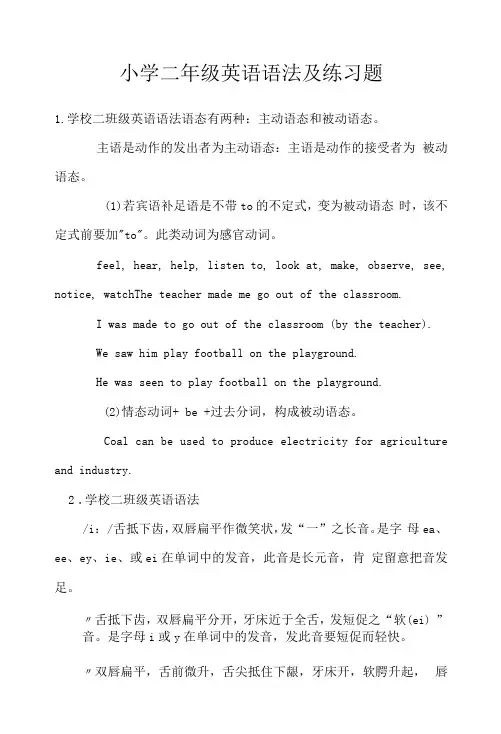
小学二年级英语语法及练习题1.学校二班级英语语法语态有两种:主动语态和被动语态。
主语是动作的发出者为主动语态:主语是动作的接受者为被动语态。
(1)若宾语补足语是不带to的不定式,变为被动语态时,该不定式前要加"to"。
此类动词为感官动词。
feel, hear, help, listen to, look at, make, observe, see, notice, watchThe teacher made me go out of the classroom.I was made to go out of the classroom (by the teacher).We saw him play football on the playground.He was seen to play football on the playground.(2)情态动词+ be +过去分词,构成被动语态。
Coal can be used to produce electricity for agriculture and industry.2.学校二班级英语语法/i:/舌抵下齿,双唇扁平作微笑状,发“一”之长音。
是字母ea、ee、ey、ie、或ei在单词中的发音,此音是长元音,肯定留意把音发足。
〃舌抵下齿,双唇扁平分开,牙床近于全舌,发短促之“软(ei) ”音。
是字母i或y在单词中的发音,发此音要短促而轻快。
〃双唇扁平,舌前微升,舌尖抵住下龈,牙床开,软腭升起,唇自然开放。
是字母a在闭音节或重读闭音节中的发音/e/舌近硬腭,舌尖顶下齿,牙床半开半合,作微笑状。
是字母e 或ea在单词中的发音/3:/舌上抬,唇成自然状态,口半开半闭,发“厄”之长音。
是字母er、ir、or或ur在单词中的发音〃舌上抬,唇成自然状态,口半开半闭,发“厄”之短音。
是字母a、0、u、e、or、er或ur在单词中的发音/a:/双唇张而不圆,牙床大开,舌后微升,舌尖向后升缩微离下齿,发阿之长音。
小学英语语法一本全第一章名词1.名词的数2.名词的格第二章代词1.人称代词2.物主代词第三章冠词与数词1.冠词2.数词第四章一般现在时态第五章现在进行时态第六章句型1.陈述句2.疑问句3.祈使句4.There be 句型与have\ has第七章总结考试名词的概念在生活中,我们会接触到各种各样的人和事物,用来表示这些人或事物名称的词就是名词。
一、名词的数名词的数指名词的单数和复数形式。
可数名词表示“一个”时用单数,“两个以上”时用复数;不可数名词表示量时,通常用“数词+单位+of+物质名词”的形式,如 a piece of bread (一片面包),变为复数时,只须将单位名词变为复数,如:two pieces of bread(两片面包)。
*名词复数的构成法则1. 一般情况下在词尾加 s. 词尾读音shop --- shops (商店) 在清辅音后读[ s ]bag --- bags (书包) 在浊辅音后读[ z ]window --- windows (窗户) 在元音后读[ z ]2. 以s, x, sh, ch 结尾的单词在词尾加es。
class --- classes (班级) 词尾读音[ iz ]box --- boxes (盒子)match --- matches (比赛)brush --- brushes (刷子)3. 以“辅音字母+y”结尾的词,变y为i 加es.story --- stories (故事) 词尾读音[ iz ]4. 以“元音字母+y”结尾的词,在词尾直接加skey --- keys 词尾读音[ z ]monkey --- monkeys5.以“o” 结尾的名词,复数一般在词尾加“s”, 但个别加“es”tomato --- tomatoes (西红柿) 词尾读音[ z ]potato --- potatoes (土豆)zoo --- zoos (动物园)photo --- photos (照片)*(以“o”结尾,复数加“es”)口诀:黑人(Negro)英雄(hero),左手拿着西红柿(tomato),右手拿着破土豆(potato),头顶一个大芒果(mango)。
【导语】英语语法是针对英语语⾔进⾏研究后,英语语法系统地总结归纳出来的⼀系列语⾔规则。
英语语法的精髓在于掌握语⾔的使⽤。
⼩学阶段的英语学习离不开语法知识,整理了⼩学三年级阶段英语语法知识总结(带练习及答案),在期末来临之际,希望对于教师的语法教学有所帮助! ⼀般疑问句及特殊疑问句 句⼦基本是:简单陈述句,由简单陈述句转变成肯定句,否定句,疑问句。
疑问句是⽤来提出问题。
英语中有四种疑问句: ⼀般疑问句、特殊疑问句、选择疑问句和反意疑问句。
我们现在已经接触到了前两种疑问句。
后两种疑问句以后我们还会学到. ⼀般疑问句: 英语中要⽤ yes和no 来回答的疑问句叫⼀般疑问句。
如: 1)Is it hot ? Yes, it is .\No, it isn't. -- be动词引导 2)Is it a car ? Yes, it is .\No, it isn't . -- be动词引导 3)Is this your ruler ? Yes, it is .\No, it isn't . -- be动词引导 4)Do you like bananas ? -- 含实义动词 Yes, I like bananas. \ No, I don't like bananas. 5)Can Ming hear a drill ? --含情态动词 Yes , Ming can hear a drill.\No,Ming can't hear a drill. 陈述句(肯定句,否定句,⼀般疑问句)的转变规律: 1.肯定句: 2.否定句: 3. ⼀般疑问句及肯否定回答 1) 主语+be动词+…. 1) 主语+be动词+not+…. 1)be动词+主语+…? Yes, 主语+be动词./ No, 主语+be动词+not. I am a teacher. I am not a teacher. Are you a teacher? --Yes, I am./ No, I am not. My mother is thin. My mother is not /isn't thin. Is your mother thin? --Yes, she is./ No, she isn't. They are insects. They are not/aren't insects. Are they insects? --Yes. they are./ No, they aren't. 2) 主语+情态动词can+… 2) 主语+情态动词can+ not+…. 2)情态动词can+主语+…? Yes, 主语+情态动词can/ No,主语+情态动词can+ not He can jump. He can not/can't jump. Can he jump? --Yes,he can./ No, he can't. 3) 主语+动词+…. 3) 主语+助动词do/does+not 3)助动词do/does+主语 +…. 动词原形 +….动词原形? Yes, 主语+助动词do/does. No, 主语+助动词do/does+not. He likes to eat apples. He doesn't like to eat apples. Does he like to eat apples? Yes,he does./ No,he doesn't. We like to eat apples. We don't like to eat apples. Do you like to eat apples? Yes,we do. /No,we don't. ⼆. 祈使句:表⽰请求、命令、建议或劝告等的句⼦叫祈使句,主语you常省略。
小学英语重点语法知识形容词副词归纳附练习小学英语形容词副词及其各种用法是英语学习过程中的一个重要模块,但是,在孩子们的眼中,形容词、副词是最难区分的,给人的感觉很模糊,可是如何的区别他们呢?他们都有什么特殊用法吗?今天平凡教研团队就来讲讲“形容词、副词”的用法吧!形容词、副词的区别形容词=名词+y / ly / ous / ive / fulEg:wind+y=windy;love+ly=lovely;danger+ous=dangerous;expense+ive=expensive;care+ful=careful副词=形容词+lyEg:careful+ly=carefully形容词、副词用法区别记忆口诀1、形名——形容词修饰名词Eg:a young girl2、动副——副词修饰动词Eg:run quickly3、系形——系动词后面跟形容词Eg:is lovely4、副形:副词修饰形容词Eg:very good形容词如何的排序?有一个房间,有很多的修饰限定词,如何给它们排序?按照如下顺序:美丑-大小-形状-新旧-颜色-国籍-材质-用途记忆口诀:美小圆旧黄,法国木书房A beautiful small round old yellow French wooden study room 形副同形词有哪些?1、Well形容词性意思:身体好的副词性意思:好地2、Fast形容词性意思:快的副词性意思:快地3、Early形容词性意思:早的副词性意思:早早地4、Hard形容词性意思:难的,硬的副词性意思:勤奋地衍生词:Hardly 几乎不5、Late形容词性意思:晚的副词性意思:晚地衍生词:Lately 最近6、Near形容词性意思:近的副词性意思:近地衍生词:Nearly 几乎7、High形容词性意思:高的副词性意思:高地衍生词:Highly 高度地比较级和最高级1.词的比较级和最高级变化规则2.比较级最高级类型(1)递增比较级构成:形/副+er+thanMore+形/副+than含义:比……更备注:More 不能与er 同时用more 后面跟形/副原级(2)递减比较级构成:less+形/副+than含义:比……更不备注:Less 后面跟形/副原级(3)同级比较构成:as+形/副+as含义:和……一样备注:As...as 中间用原级(4)同级否定比较构成:Not as/so+形/副+as含义:不像……一样备注:As...as 中间用原级3.比较级最高级的标志词比较级:两者比较;than;最高级:三者比较,in/of+范围,one of;I have ever seenEg:He is the tallest boy in our class/of all the students.It is the best car I have ever seen.比较级修饰:much,a lot,far,a little, evenEg: much bigger; far fatter4.比较级经典句型(1)越来越:比较级+and+比较级Eg:The world will become better and better.世界会变得越来越好。
小学英语语法大全-附练习题Contents第一章名词1.名词的数2.名词的格第二章代词1.人称代词2.物主代词第三章冠词与数词1.冠词2.数词第四章一般现在时态第五章现在进行时态第六章句型1.陈述句2.疑问句3.祈使句4.There be 句型与have\ has第七章总结考试第一章名词(Noun)名词的概念在生活中,我们会接触到各种各样的人和事物,用来表示这些人或事物名称的词就是名词。
一、名词的数名词的数指名词的单数和复数形式。
可数名词表示“一个”时用单数,“两个以上”时用复数;不可数名词表示量时,通常用“数词+单位+of+物质名词”的形式,如a piece of bread (一片面包),变为复数时,只须将单位名词变为复数,如:two pieces of bread(两片面包)。
*名词复数的构成法则1. 一般情况下在词尾加 s. 词尾读音shop --- shops (商店) 在清辅音后读[ s ]bag --- bags (书包) 在浊辅音后读[ z ]window --- windows (窗户) 在元音后读[ z ]2. 以s, x, sh, ch 结尾的单词在词尾加es。
class --- classes (班级) 词尾读音[ iz ]box --- boxes (盒子)match --- matches (比赛)brush --- brushes (刷子)3. 以“辅音字母+y”结尾的词,变y为i 加es.story --- stories (故事) 词尾读音[ iz ]4. 以“元音字母+y”结尾的词,在词尾直接加skey --- keys 词尾读音[ z ]monkey --- monkeys5.以“o”结尾的名词,复数一般在词尾加“s”, 但个别加“es”tomato --- tomatoes (西红柿) 词尾读音[ z ]potato --- potatoes (土豆)zoo --- zoos (动物园)photo --- photos (照片)*(以“o”结尾,复数加“es”)口诀:黑人(Negro)英雄(hero),左手拿着西红柿(tomato),右手拿着破土豆(potato),头顶一个大芒果(mango)。
完整版)小学英语语法及练习题Lesson One: Personal PronounsPersonal pronouns have three forms: subject form (used as the subject of a sentence)。
object form (used as the object of a verb or n)。
and possessive form (used to show ownership or nship)。
They can be placed at the beginning or end of a sentence。
or before a noun。
Subject Form Object Form Possessive FormI me XXXyou you yourhe him hisshe her hersit it itswe us our oursthey them their theirsExamples:1.Are these your pencils。
Yes。
they are ours.2.Whose is this pencil。
It's XXX.3.I love them very much.4.XXX.5.Miss Li often looks after her XXX.6.Are these their bags。
No。
they XXX.7.That is not my kite。
That kite is very small。
but mine is very big.8.The dress is hers。
Give it to her.9.Is this your watch。
No。
it's not XXX.1.This bike is my sister's。
It belongs to her.2.This isn't my book。
外研社小学英语一起小学五年级上语法总结及练习题I。
There be句型的一般现在时与一般过去时1.There be一般现在时:There be句型用来表示某地是否有某物或某人,构成方式为:be动词后紧跟着名词。
肯定句的形式为:There is + 可数名词单数/不可数名词 + 地点,There are + 可数名词复数 + 地点。
否定句则在is/are后面加上not,即There XXX’t + 可数名词单数/不可数名词 + 地点,There aren’t + 可数名词复数 + 地点。
一般疑问句的形式为:Is/Are there + 名词 + 地点 + 地点?回答肯定为Yes。
there is/are。
否定为No。
there isn’t/aren’t。
针对数量提问的特殊疑问句的形式为:How many + 名词复数+ are there + 地点?How much + 不可数名词 + is there + 地点?2.There be一般过去时:There be句型用来表示过去某地是否有某物或某人,时间状语可以是昨天、早上、晚上等,也可以是由“last+一时间名词”构成的短语,如last night。
last year等,还可以是由“时间段+ago”构成的短语,如a moment ago。
a short time ago。
an hour ago等。
肯定句的形式为:There was + 可数名词单数/不可数名词 + 地点,There were + 可数名词复数 + 地点。
否定句则在was/were后面加上not,即XXX 可数名词单数/不可数名词 + 地点,There weren’t + 可数名词复数 + 地点。
一般疑问句的形式为:Was/Were there + 名词 + 地点 + 地点?回答肯定为Yes。
there was/were。
否定为No。
XXX’t。
针对数量提问的特殊疑问句的形式为:How many + 名词复数 + were there + 地点?How much + 不可数名词 + was there + 地点?就近原则:在there be句型中,be动词用单数还是复数取决于离它最近的那个名词的数量。
小学英语语法及习题一:小学英语语法总结:小学英语语法总体上有如下四大块:1. 名词的单数和复数变化规则.2. 时态(小学阶段有学系了四种时态:即一般现在时,现在进行时, 一般将来时,一般过去时) 包含一般现在时: 一般现在时的功能,构成,变化(包括动词的变化和句式的变化)现在进行时: 现在进行时的概念, 构成, 变化(包括动词的变化: 动词+ing的变化规则; 句式的变化)一般将来时: 一般将来时的概念, 构成, 变化(句式的变化)一般过去时: 一般过去时的功能, 构成, 变化(包括动词的变化: 动词的过去式的变化规则, 不规则动词的过去式列表)上述语法内容主要的操练方式是两种: 1.动词的恰当方式填空2.按要求进行句式变换. (肯定句,否定句,疑问句之间的互相转化)一、名词复数规则1.一般情况下,直接加-s,如:book-books, bag-bags, cat-cats, bed-beds2.以s. x. sh. ch结尾,加-es,如:bus-buses, box-boxes, brush-brushes, watch-watches3.以“辅音字母+y”结尾,变y为i, 再加-es,如:family-families, strawberry-strawberries 4.以“f或fe”结尾,变f或fe为v, 再加-es,如:knife-knives5.不规则名词复数:man-men, woman-women, policeman-policemen, policewoman-policewomen, mouse-micechild-childrenfoot-feet,.tooth-teethfish-fish, people-people, Chinese-Chinese, Japanese-Japanese写出下列各词的复数I _________him _________this ___________her ______watch _______child _______photo ________diary ______day________ foot________ book_______ dress ________tooth_______ sheep ______box_______ strawberry _____thief _______yo-yo ______ peach______ sandwich ______man______ woman_______ paper_______ juice___________water________ milk________ rice__________ tea__________二、一般现在时一般现在时基本用法介绍【No. 1】一般现在时的功能1.表示事物或人物的特征、状态。
如:The sky is blue.天空是蓝色的。
2.表示经常性或习惯性的动作。
如:I get up at six every day.我每天六点起床。
3.表示客观现实。
如:The earth goes around the sun.地球绕着太阳转。
一般现在时的构成1. be动词:主语+be(am,is,are)+其它。
如:I am a boy.我是一个男孩。
2.行为动词:主语+行为动词(+其它)。
如:We study English.我们学习英语。
当主语为第三人称单数(he, she,it)时,要在动词后加"-s"或"-es"。
如:Mary likes Chinese.玛丽喜欢汉语。
一般现在时的变化1. be动词的变化。
否定句:主语+ be + not +其它。
如:He is not a worker.他不是工人。
一般疑问句:Be +主语+其它。
如:-Are you a student?-Yes. I am. / No, I'm not.特殊疑问句:疑问词+一般疑问句。
如:Where is my bike?2.行为动词的变化。
否定句:主语+ don't( doesn't ) +动词原形(+其它)。
如:I don't like bread.当主语为第三人称单数时,要用doesn't构成否定句。
如:He doesn't often play.一般疑问句:Do( Does ) +主语+动词原形+其它。
如:- Do you often play football?- Yes, I do. / No, I don't.当主语为第三人称单数时,要用does构成一般疑问句。
如:- Does she go to work by bike?- Yes, she does. / No, she doesn't.特殊疑问句:疑问词+一般疑问句。
如:How does your father go to work?动词+s的变化规则1.一般情况下,直接加-s,如:cook-cooks, milk-milks2.以s. x. sh. ch. o结尾,加-es,如:guess-guesses, wash-washes, watch-watches, go-goes 3.以“辅音字母+y”结尾,变y为i, 再加-es,如:study-studies一般现在时用法专练:一、写出下列动词的第三人称单数drink ________ go _______ stay ________ make ________look _________ have_______ pass_______ carry ____come________ watch______ plant_______ fly ________study_______ brush________ do_________ teach_______二、用括号内动词的适当形式填空。
1. He often ________(have) dinner at home.2. Daniel and Tommy _______(be) in Class One.3. We _______(not watch) TV on Monday.4. Nick _______(not go) to the zoo on Sunday.5. ______ they ________(like) the World Cup?6. What _______they often _______(do) on Saturdays?7. _______ your parents _______(read) newspapers every day?8. The girl _______(teach) us English on Sundays.9. She and I ________(take) a walk together every evening.10. There ________(be) some water in the bottle.11. Mike _______(like) cooking.12. They _______(have) the same hobby.13. My aunt _______(look) after her baby carefully.14. You always _______(do) your homework well.15. I _______(be) ill. I’m staying in bed.16. She _______(go) to school from Monday to Friday.17. Liu Tao _______(do) not like PE.18. The child often _______(watch) TV in the evening.19. Su Hai and Su Yang _______(have) eight lessons this term.20. -What day _______(be) it today?-It’s Saturday.三、按照要求改写句子1. Daniel watches TV every evening.(改为否定句)___________________________________________________2. I do my homework every day.(改为一般疑问句,作否定回答)________________________________________________________3. She likes milk.(改为一般疑问句,作肯定回答)___________________________4. Amy likes playing computer games.(改为一般疑问句,作否定回答)___________________________________________________5. We go to school every morning.(改为否定句)_______________________________________________________6. He speaks English very well.(改为否定句)___________________________________________________7. I like taking photos in the park.(对划线部分提问)________________________________________________________8. John comes from Canada.(对划线部分提问)___________________________________________________9. She is always a good student.(改为一般疑问句,作否定回答)________________________________________________________10. Simon and Daniel like going skating.(改为否定句)___________________________________________________五、改错(划出错误的地方,将正确的写在横线上)1. Is your brother speak English? __________________2. Does he likes going fishing? __________________3. He likes play games after class. __________________4. Mr. Wu teachs us English. __________________5. She don’t do her homework on Sundays. _________________三、现在进行时1.现在进行时表示现在正在进行或发生的动作,也可表示当前一段时间内的活动或现阶段正在进行的动作。